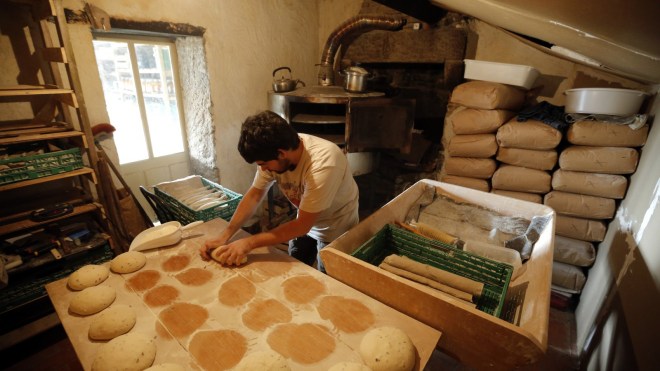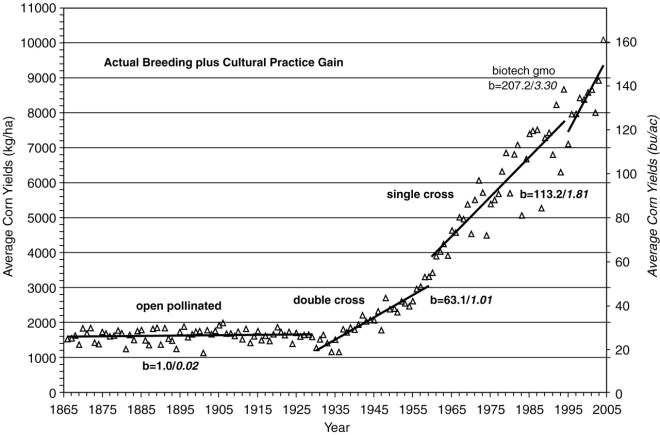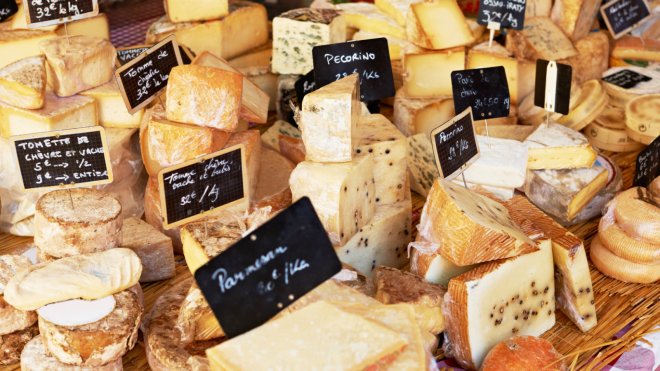Debates rage over what to do about genetically modified organisms, but we rarely stop to ask a more basic question: Do GMOs really exist? It’s an important question, because no one in this debate can tell you precisely what a GMO is. I’ve come to the conclusion that “GMO” is a cultural construct. It’s a metaphor we use to talk about a set of ideas. It doesn’t map neatly onto any clear category in the physical world.
GMOs, like other cultural constructs — think of gender, or race — do have a basis in reality, of course: We can roughly define “male” or “Asian,” but when we try to regulate these divisions, all kinds of problems crop up. And definitions of “GMOs” are much messier — “nerd” might be a roughly equivalent category. You know what a nerd is, but things would break down fast if you were required to label and regulate all the nerds. The definition of a nerd depends on the context; it depends on who’s asking. Same with GMOs.
As one researcher put it, “It is theoretically and practically impossible to precisely specify a supposed common denominator for all these [GMO] products.”
This causes real problems. People argue about GMOs because they are worried about safety, or environmental integrity, or human rights. But because the category is so porous, any policy governing “GMOs” — whether encouraging or discouraging them — can work directly against those values.
By now you are probably protesting that you’ve seen definitions that work well enough. (I’ve doubtless taken a stab at providing one at some point.) But let’s zoom in to take a look at how well those definitions fare in practice.
Definition: Moving genes from one species to another
Moving genes between species is called transgenesis. This seems like a hard line, and mostly (we’ll get to this later, when we talk about nature), it really is. Scientists today can perform some gene imports that simply weren’t possible in the past, like splicing a bacterial gene into eggplant.
But defining GMOs as transgenics leaves out a lot: It doesn’t encompass gene silencing, where scientists use lab techniques to turn off a gene, and many forms of gene editing — which has just become radically easier with the CRISPR breakthrough, and is therefore booming. The biotech company Cibus is altering the genes of plants in hopes of serving the growing demand for non-GMO foods. Though Cibus is modifying genes, it is just making internal tweaks, not introducing any foreign DNA, so it’s not making GMOs under this definition — a definition that is enshrined in U.S. policy, by the way.
This definition also leaves out mutagenesis: exposing plants to radiation or mutagenic chemicals to scramble or “modify” genes. This, as you might imagine, is more likely to cause unintended outcomes than transgenesis. All the critical attention to GMOs, and all the regulation aimed at catching any potential risk from transgenesis, has led companies to focus more on mutagenesis. As Bloomberg reporter Jack Kaskey found:
Earnings at BASF’s agriculture unit rose 27 percent in 2012 from the previous year, partly because of higher demand for mutant seeds in Eastern Europe, according to the company’s latest annual report. “The flexibility is there to use this technology quite broadly,” says Jonathan Bryant, vice president of the global strategic marketing group for herbicides at BASF. “Because it’s a conventional breeding technique … it’s very amenable for a wide range of seed companies.”
In other words, our attempts to minimize risk by regulating “GMOs” has created a boom in a riskier form of genetic modification.
The solution seems obvious: Expand the definition! Aren’t you committing genetic modification anytime you are mucking about with genes? What if we define a GMO as …
Definition: Anything that couldn’t occur naturally
The problem with this is that it casts so broad a net that it catches all sorts of things that we don’t normally think of as GMOs. This definition would include grafting trees — the technique of splicing the branches of one species onto the root stock of another. Grafting is an old-timey way of breaking the species barrier and combining the best traits of two organisms that couldn’t breed. But grafting doesn’t actually alter genes, so we could exclude it with a little tweak: “an organism in which the genetic material has been altered in a way that does not occur naturally through fertilization and/or natural recombination.” This is how the European Union defines GMOs.
But even with the tweak, the definition catches a lot of cool varieties that farmers have come to depend on. For example, there’s a French variety of wheat called Renan which is especially useful to farmers who don’t use pesticides because it is very disease-resistant. It was bred in the 1940s and has passed on its traits to many other wheat varieties. Stephen Jones, at the celebrated Washington State University Bread Lab, is currently working with a descendant of Renan adapted for the West Coast of the U.S. Its genes have spread far and wide.
Renan was made by breeders who coaxed the genetic material from wheat, and two other distantly related species, to combine. To do this, they bathed the plants in colchicine, which keeps chromosomes from hooking back up after they split during cell division — doubling the number of chromosomes in the plants. Later, they exposed the plants to X-rays to scramble some of the DNA, but eventually they got the combination of traits that they wanted. As Ontario farmer and former crop-science professor Terry Daynard wrote:
“So what’s the difference between Renan and many other GM crop varieties? Not much it appears except for the fact that Renan contains much more transgenic material, has not undergone the large amount of testing for safety and environmental impact as other GM events, and little is known about the mechanisms of the transferred genes.
Think of that while you enjoy your baguette at an organic café sur la Rive Gauche, Paris.”
Renan hasn’t undergone testing because the European Union decided that GMOs created with these techniques were exempt. There were just too many good crops coming from these techniques — and already in circulation — to subject them all to the scrutiny that has thwarted many transgenic crops. The same was true of mutagenesis. There are just so many wonderful mutants: disease-resistant cocoa, my favorite organic brown rice, barley used for craft beer and expensive whiskey,the Star Ruby and Rio Red grapefruits, peas, pears, peanuts, peppermint, and thousands more.
In the U.S., when the National Organic Standards Board defined GMOs in 1995, it started with something similar to the E.U., but sought to revise the rule in 2012. When the board members began doing research for the revisions, they found that, under their existing definition, lots of organic farmers were growing GMOs.
Exploring this issue has brought to the attention of the subcommittee that engineered genetic manipulation of plant breeding materials has already occurred in many of the crop varieties that are currently being used in organic farming. A partial list:
- Disease resistant tomatoes (embryo rescue to introduce resistance genes)
- wheat and barley (double haploid technology using wheat and corn crosses along with embryo rescue and colchicine gene doubling)
- hybrid corn parent lines (double haploid to get homozygosity in 1 generation)
- Seedless tangerines and mandarins (mutations through irradiation)
- Brassica hybrids (cell fusion from radish traits)
Many of these techniques that were used in initial crosses that have now passed down through many generations may not be traceable any longer.
This came up again in 2014, when Humboldt County, Calif., voted to ban GMOs under the 1995 organic definition. In an editorial, biology professor Mark Wilson noted that the measure could backfire:
[I]t seems likely that many local farmers are growing crops that somewhere in their history underwent gene doubling, or cell fusion. The farmers who planted these crops are almost certainly unaware of their breeding histories.
What would happen if one of the massive GMO corporations (which have been conspicuously silent), or even just a mischievous student, stepped in, not to challenge the Measure P definitions but to force the county to actually follow the letter of the law? Farmers would have 30 days to destroy crops that they had planted in good faith, and more importantly crops that there is no rational reason to think are somehow dangerous. A major disruption to our local farmers is possible.
No one has tried to push strict enforcement to force organic farmers to destroy such “GMOs,” fortunately. Still, a purist might insist that that’s the only sensible route: At least we can draw a hard line between basic, vanilla, plant reproduction, and genetic alteration that wouldn’t occur in nature, right? Right? Wrong.
Nature is a genetic engineer
The biggest problem with defining GMOs as the product of “unnatural sex” is that nature has tried it all. As genetic engineers, we have gotten a little kinky in dabbling with some corn bondage. That’s nothing: Nature is the Marquis de Sade. It’s been having massive interspecies orgies for millennia, and is raising the resulting children.
For a long time, people thought that genes didn’t jump around from one species of plant to another. But then some scientists found that a gene that had somehow jumped between rice and barley. Then, scientists started finding more. At this point, it looks like basically all plants have some cross-species hanky-panky in their family tree.
When I asked on Twitter for examples that defied the lay definition of GMO, I got lots of responses, including notes about sweet potatoes …
https://twitter.com/jamerz_af/status/677227178270953472… and a reference to this crazy paper about a plant virus that infected a vertebrate and began trading DNA inside that animal.
@prometheusgreen @BioBeef @SavorTooth Retroviruses, DNA inversions & translocations...a wild world. Genome editing is tame by comparison.
— Paul Vincelli (@Pvincell) December 17, 2015
Parasites alter the genes in their hosts all the time. Bacteria trade genes between species constantly. If we define GMOs as gene combinations that nature would not make, then nothing is a GMO. So what if we defined GMOs as the result of human genetic modification?
Definition: Genetic modification done by humans
This definition also runs into immediate problems, because any domestication through breeding modifies genomes. The farmer selecting seeds from the best plant is, under this definition, a genetic engineer. I think even the purists would agree that is far too broad. That’s what we want, right? A farmer selecting seeds is in a coevolutionary relationship with the crop; the changes are happening slowly enough so that the effects on the larger environment are apparent. So let’s tweak the definition again: A GMO is an organism bred by a human using modern genetic engineering techniques, in a lab, rather than on the land.

CSIRO wheat breeder Greg Rebetzke works on climate-ready crops at a laboratory in the Canberra, Australia. Inside, hundreds of seedlings on a conveyor belt file through a high-tech chamber, each plant bar-coded and scanned for signs of genetic superiority. REUTERS/David Fogarty
I think this definition comes the closest to what most people think of when they hear “GMO.” This version of “GMO” means seeds controlled by a corporation far from the natural context, rather than seeds controlled by small farmers in intimate dialogue with the elements. Non-GMO is Jeffersonian, while GMO is Hamiltonian.
The problem here is that most people don’t realize how far we’ve come from farmers breeding seeds to fit their land. With a few exceptions, seed breeders use high-throughput techniques and tissue culture to accomplish in one season what would have previously taken a generation, and they’ve been doing this for half a century. There are a few farmers and seed companies that work only with open-pollinated non-hybrids, but just a few. Under this definition, most of the foods that give you warm-fuzzy childhood memories are GMOs.
The thing is, having farmers be co-evolutionary seed breeders didn’t work very well. For centuries, crop yields were essentially flat. When professional breeders started to figure out genetics, yields took off.
This is why most farmers pay top dollar for commercial seeds every year, rather than saving free, traditional varieties. Plant breeder Matt DiLeo, who made the graph above, writes:
I think I’ve seen some variation of this graph in about half of the maize research presentations I’ve ever sat through. It displays the amazing increase in U.S. average corn yields since the appearance of professional plant breeders. I’ve been told that about 60 percent of this increase in yield is due to genetics (primarily the introduction of hybrid seed) and about 40 percent is due to agronomy (improved fertilization, tillage, herbicides and denser planting).
This increase in yield is environmentally important. If we really wanted to go back to the yeoman farmers working in patient co-evolution with crops, we’d have to massively expand agriculture’s footprint.
We can’t strictly define GMO, but we know it when we see it
Supreme Court Justice Potter Stewart faced a similar failure of definitions when he trying to explain what comprised “hardcore” pornography. He wrote: “I shall not today attempt further to define the kinds of material I understand to be embraced within that shorthand description; and perhaps I could never succeed in intelligibly doing so. But I know it when I see it.”
Like porn, GMOs defy strict definition because, like porn, GMOs are a cultural construct with borders that shift with the times. Perhaps the most accurate definition of GMO is social and contextual: Organisms breed in a way that people find threatening. Before GMOs, people objected to cross-pollinating flowers, on the grounds that gardeners were playing God. If that were a concern today we’d surely consider these engineered flowers GMOs. This cultural definition doesn’t make for firm borders, but there is a fuzzy collection of attributes — a gestalt — that we can all comprehend.
How else can you explain cheeses? Think of a wheel of farmhouse cheese — it certainly doesn’t fit the GMO gestalt. But cheesemakers need an enzyme to separate the curds from the whey, and most today use a genetically engineered version of that enzyme. Once, everyone used rennet. You get rennet by scraping the inside of a calf’s stomach. But over the years we’ve started eating more cheese and less veal, which means there aren’t enough calf stomachs laying around. The solution was a genetically engineered bacterium that produces the same enzyme. But, perhaps because the bacteria themselves stay in the lab, or perhaps because it was never politicized, cheese doesn’t feel like a GMO.
Why does this matter? Because once people understand how mushy the definition of GMOs really is, they start to realize how hard it would be to make substantive change by regulating GMOs.
There are GMOs that reduce pesticide spraying, and GMOs that increase pesticide spraying. There are GMOs designed to serve monoculture, and GMOs made for small farmers with mixed plots. There are GMOs made to work hand-in-hand with herbicide, and non-GMOs made to work hand-in-hand with herbicide. There are GMOs controlled by big corporations, and GMOs given away for free by universities.
The question “to GMO or not to GMO” isn’t really useful. The real question we should be asking is this: How fast, and in what directions, should agricultural innovation advance?








